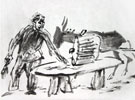
展览时间:2011-06-11 ~ 2011-07-10
展览地点:其他画廊
参展艺术家:萨维·斯坦尼卡斯、保罗·斯坦尼卡斯
开幕酒会:2011-06-11 17:00~19:00
展览介绍:
萨维·斯坦尼卡斯和保罗·斯坦尼卡斯:“祭坛”
萨维·斯坦尼卡斯(Svajonė Stanikas)和保罗·斯坦尼卡斯(Paulius Stanikas)在法国巴黎生活和工作。他们成功举办过一系列个展,并参与了国际上重要的艺术活动(如威尼斯双年展,利物浦双年展,北京双年展等)。
这两位艺术家使用素描,摄影,雕塑,影像,文本,现成物或获取物(常常体现了作品展览所在地的地方特色)等媒介,结合空间中的声光效果,创作复杂的现场装置作品,避免使用任何常规的单一艺术形式。
就艺术观念而言,两位艺术家喜欢在创作中将大众传媒图像和主观图像,庸俗文化的象征和传统文化象征,虚伪和真诚,轶事和史诗,“纯美学”和意识形态,戏仿和悲剧(尽管往往倾向于后者)等元素融合起来,设法在观念上找到美学和伦理的结合方式,以免艺术退化为一种自说自话的和说教。
在他们的展览中,各种不同的形式和观念元素结合成一个整体,其中不仅包含媒体和物品,也包含历史,文化和自传的成分(两人的摄影和影像作品往往也以他们自己的私人生活为主题)。在某种意义上,他们的装置作品把“史诗般的”逻辑、结构、深度和艺术家的个人体验结合起来,让人想到但丁的《神曲》和弗朗索瓦·拉伯雷的《巨人传》那样内容丰富的巨著,或以其超象征的性质,暗示《易经》的种种当代版本。《易经》中的内容常常被重新诠释,以便服务于当代市场和消费者的需求。
尽管一个可怕的整体是由身体(通常是艺术家自己的身体)和萨德侯爵式的激进的肉体混合而成,但男性和女性的身份(或广义的阴和阳)才是两位艺术家图像中最重要的部分。他们作品的符号、象征和比喻所具有的语义学力量可以理解为灵魂的辩证法,在此辩证法中善和恶的各种表现形式相互较量。
在为本次名为“祭坛”的展览制作的装置作品中,艺术家将各种元素结合在一起,包括文艺复兴时期那种(同时也是非常当代的)夸饰的素描,以自相矛盾的视觉为灵感的摄影,莫名其妙的自传影片《地狱》,以及现成物或获取物。这最后一个元素将所有媒介整合起来,或者反过来说,将所有媒介融为一体。本次展览的视觉特征是单色的,就好像暗示着祭坛这个神圣概念的语义,这种语义和各种社会文化仪式——从婚礼到葬礼——有关,在这些仪式中黑色和/或白色具有重要的含义。在此意义上,本次展览也暗示着当代世界整体商业化的倾向,商品陈列的橱窗成为当下全球社会文化仪式的核心。
因此,萨维·斯坦尼卡斯和保罗·斯坦尼卡斯以一种矛盾的方式探讨了身体和灵魂在文化上的对立,激活并重构了主体和集体的原型神话样式(archetypal mythologems)。与此同时,通过商业广告般的视觉风格,他们也论及语义和符号系统,思考,信仰,自我实现,原型,当代世界中的自我等问题,探讨了它们的变化和矛盾。
S & P Stanikas: Altars
Svajonė ir Paulius Stanikas live and work in Paris. They successfully organise solo exhibitions and participate in prominent art events all over the world (the biennials of Venice, Liverpool, Beijing, etc.).
The artists create complex in situ installations, which consist of drawings, photographs, sculptures, videos, texts, found and acquired objects (that usually reflect the specifics of the country where the works are presented), and the interplay of light and sound in the space, avoiding the use of the conventions of any single defined single.
Concept-wise, Svajonė and Paulius Stanikas constantly balance between images derived from the mass media and subjective images, kitsch and millennia-old fundamental cultural symbols, simulation and sincerity, anecdote and epos, “pure aesthetics” and ideology, parody and tragedy (albeit gravitating towards the latter) in their work, managing to associatively find combinations of the aesthetic and the ethical that nevertheless do not become declaratory and didactic.
Numerous formal and conceptual levels form an integral whole in the Stanikas’ exhibitions, which encompass not only the object/media components, but also the historical, cultural, and autobiographic ones (the Stanikas’ photography and video works often reflect their personal, autobiographic spacetime as well). In a sense, the installations’ “epic” logic, structure and depth, combined with personal experience, come close to such landmark multifaceted works as Dante’s The Divine Comedy and François Rabelais’ Gargantua and Pantagruel, or allude through their meta-symbolic nature to the contemporary versions of the Book of Changes, which are frequently adapted to the current demands of the market and the consumers.
Although it is the body (usually the artists’ own) and the radical de Sadean corporeality that blends into one macabre whole the masculine and the feminine identities (or yin and yang in the broader sense) that are the most important elements of the Stanikas’ iconography, the semantic energy of the signs, symbols, and metaphors used in their works can be interpreted as the dialectic of the soul, in which multiple manifestations of good and evil fight each other.
The Stanikas weave the present exhibition, titled Altars, from Renaissance-like (and, at the same time, deeply contemporary) grandiose drawings, photographs that exploit visual paradoxes, the delirious autobiographical video titled Inferno, and found/acquired objects that join or, conversely, dissolve all of these media. The exhibition’s visual code is monochrome, like an allusion to the semantics of the sacred notion of an altar, which is associated with various socio-cultural rituals – from wedding to funeral – where the prominence of black and/or white is important. In this sense, the exhibition also alludes to the total commodification of the contemporary world, in which window-cases filled with artefacts become the heart of today’s global socio-cultural rituals.
Thus, exploring, in a paradoxical way, the fundamental cultural opposition between body and soul, the Stanikas activate and reconstruct the subjective and collective archetypal mythologems, yet by working in a vivid advertising-like visual style, they simultaneously speak about the transformations and paradoxes of the semantic and symbolic systems, thinking, faith, self-realisation, archetypes, and the self in today’s world.
- 2011-05-28 ~ 2011-06-13记·忆:当代油画人物联展
- 2011-05-28 ~ 2011-06-24“远与近”意大利当代著名艺术家作品展
- 2011-05-29 ~ 2011-07-08宁静是空间:戴乐摄影展
- 2011-06-11 ~ 2011-07-10祭坛
- 2011-06-18 ~ 2011-06-30潘璠个展
- 2011-06-19 ~ 2011-08-01又一年——王志东油画作品展
- 2011-06-11 ~ 2011-07-21PINK——当代艺术中的女性意识
- 2011-06-01 ~ 2011-06-08重叠景色——观看之道
- 2011-06-04 ~ 2011-06-30象由心生:中国抽象艺术第四回展
- 2011-06-05 ~ 2011-06-16一人·一江秋:于新个展




